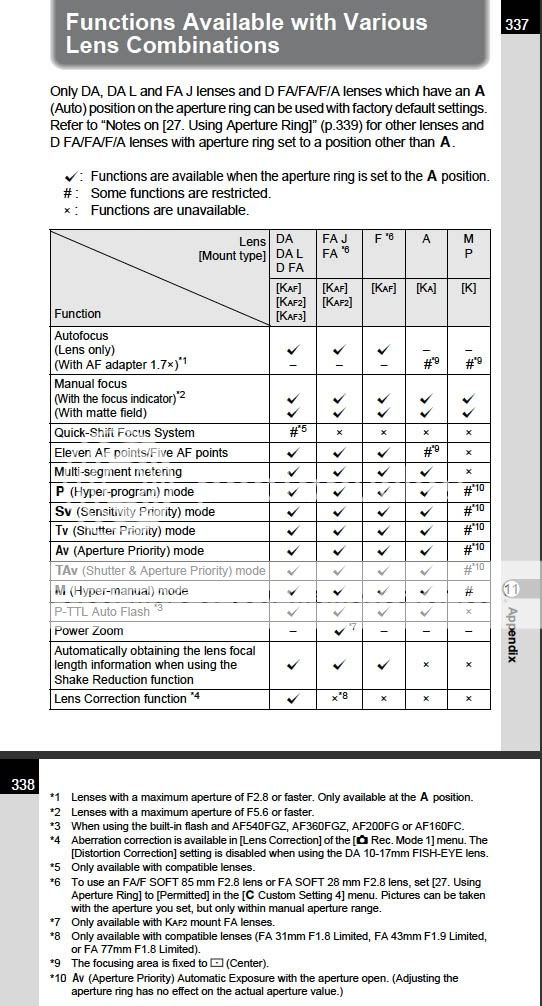 Originally posted by wombat2go
Originally posted by wombat2go 
Lowell, Can you explain further about metering "out of A position"
As I know it you then have to be in M mode, and use the stop down button , whereby the lens is actually stopped down to the aperture on the ring and the camera meters the real light.
Are you saying there are errors there?
That is exactly what I am saying. each camera I own, *istD, K10D, K7D and K5 D have their own behavior when metering using the green button, and manual aperture lenses. Except for the really flat line, each curve represents a lens on one of the cameras / with one of the focusing screens tested, in manual mode doing stopped down metering.
The *istD, and K5D have very similar errors as a function of aperture, but they are within +/- 1/2 stop of nominal exposure across the entire aperture range of the lens, and really can be lived with.
the K10D is a disaster, with under exposure by as much as a stop below F2.8 and over exposure by about 2 stops at F11. there is no way of knowing exactly the source of the error, other than part of this is related to the focusing screen and its reflective behavior, I suspect (and this is my own thinking, with no other proof) due to the scattering of light off the focusing screen due to light that hits at other than a right angle. As you stop down, light becomes more and more normal to the focusing screen.
the K7 is better but can still drift by -1/2 +1 stop, or about 1/2 the drift of the K10D.
as for taking a lens out of A, this removes the connection between the 3rd pin from the lens locking pin to the lens mount, which is needed to tell the camera that there is an A lens mounted. In this case, the A lens behaves just like a K lens, and you can see the change in exposure accuracy by physically stopping down and reading the light, as opposed to reading the light wide open, and compensating for the known error vs maximum aperture, and calculating the correct shutter speed to match the aperture.
Just look at the difference for the A50/1.2 in the A position and out of it.
The history of this issue, began with some anecdotal comments about erratic metering on the K10D, and almost at the same time, questions about exposure errors due to the use of a teleconverter. I did some testing using my sigma 70-200/2.8EX and both 1.4x and 2X TCs. what I noticed was that I needed about .7 stops with a 1.4x and 1.3 stops with a 2x. Then I went and did some other testing, determining that for normal contrast settings, from about 25 greyscale to 225 grey scale in the histogram, each stop is linear and has about a 40-45 greyscale value. Then I did the plot for my K50/1.4 and it all became apparent.
If you consider adding a 1.4x TC, my 70-200/2.8 becomes an F4 lens If you look at how a K10D meters at F2.8 and F4, there is a difference in greyscale reading of about 40 which is 1 stop. The TC feeds the aperture directly through to the camera without modification, hence it is putting the wrong correction , if you add a 2x, there is even more error, because the camera still thinks there is an F2.8 lens attached but it is actually an F5.6
This is how it all came about historically many years ago.


 Similar Threads
Similar Threads 





 . When I take my Sigma macro off the A setting, every image records max aperture.
. When I take my Sigma macro off the A setting, every image records max aperture.
 ). From that 'test' shot I will know what to set next. With time, I have gotten used to this and getting better, and I seems to be able to sense and calculate everything right -less test shots needed, probably like Sunny 16. Perhaps this is just too Jurassic, a waste of technology, but it works for me.
). From that 'test' shot I will know what to set next. With time, I have gotten used to this and getting better, and I seems to be able to sense and calculate everything right -less test shots needed, probably like Sunny 16. Perhaps this is just too Jurassic, a waste of technology, but it works for me. 














